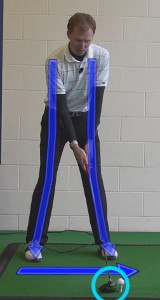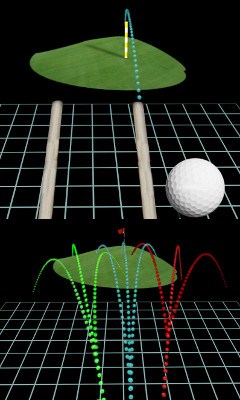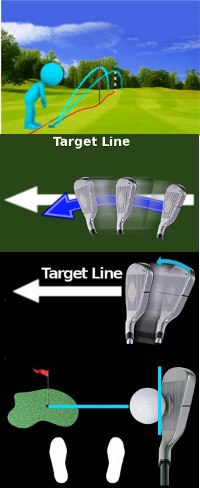
A multitude of variables must be considered when deciding exactly how to play each golf shot. The most important factor, of course, is your target.
True, the shortest distance between any two points is a straight line. But golf isn't about straight lines. (As the great Ben Hogan famously said, “You only hit a straight ball by accident.”) Most every shot curves, whether we want it to or not.
That's why the target determines your alignment, which controls the shot's trajectory and shape.
Here's an example:
The hole: 375-yard par 4, dogleg left around trees
The target: Center of the fairway
The details: The trees will catch any shot that starts more than 10 yards left of center, ruling out a fade. Therefore, the proper shot shape is a slight draw which starts down the fairway's right border and avoids trouble on the left. However, too much right-to left movement or excess roll and you risk running through the fairway and into the woods. That means a high trajectory is your best bet for holding the fairway.

When we chose the target, we dictated the terms for the shape and height of the shot. And those two factors tell you exactly how to line up to play a high draw:
- Clubface aimed at the fairway's center.
- Feet, hips and shoulders aligned with the right side of the fairway.
- Ball slightly forward in the stance.
If the high draw isn't in our repertoire, we've got to pick a target right of the fairway's middle. This will give us a bit more room to start the ball left without hitting the trees, should we prefer to hit a fade. Playing a low draw toward the right-center will effectively widen the area for the ball to run out.
Other variables – wind speed and direction, ground conditions, stance position (sidehill, etc) – will always enter the equation. But your preparations for every shot begin with the target.

Target Determines Alignment Trajectory and Shot Shape
Golf is a target-based game. That is a simple sentence, but it should tell you a lot about how you approach the challenge of moving your ball around the course. Each shot needs to have a target, and that target might not always be the one you think of at first. Is the center of the fairway going to be your target for every tee shot? Not necessarily. Is the hole location going to be your target for every approach shot? Again, not necessarily. Golf is a complex game, and you need to think your way around the course at an advanced level if you expect to have success.
In this article, we are going to talk about the topic of targets in golf. How do you pick your target, and how do you base the rest of your plan for a given shot around that selected target? If you are like the majority of golfers, you haven't spent much time thinking about this subject. That's okay – we'll help bring you up to speed with the content below. By the time you are finished with this article, you should have a clear picture of how your target determines the way you approach each and every shot during a round of golf.
As you already know, it is important to use practice time to develop your skills for the golf course. Most of the time, golfers think about using practice to train their bodies – in other words, they work on mastering the mechanics of various different shots while on the range. That is important work, but it is only half the battle. You can also use your time on the range to improve your performance from a mental standpoint. Picking targets and planning shots are skills just like anything else, and you will get better at them if you commit to practicing regularly. While on the range, don't just line up a bunch of practice balls and swing away. Instead, treat every swing like it is a shot during an actual round of golf. Pick your target, plan out the flight of the ball, and make a great swing. By going through this whole process each time, your practice will be far more productive in the end.
It is also worth noting that every golfer should be concerned with picking targets – this is not a subject which only applies to advanced players. Even if you don't have a consistent golf swing just yet, you should still invest yourself in the process of finding a target and planning a ball flight. Sure, many of your shots will not come off the way you planned, but that's okay. No one is perfect in this game. Keep at it, and you will find that more and more of your shots will be successful as time goes by.
All of the content below is based on a right-handed golfer. If you play left-handed, please reverse the directions as necessary.

Understanding the Concept of Target Line
The way you should plan your golf shots as you move around the course can be a little bit confusing, especially for a beginning golfer. As we have already mentioned, you aren't necessarily going to use the ultimate target – the hole – as your aim point on a given shot. There are a couple of factors at play here. First is the fact that your ball is not going to fly straight on nearly any occasion. Even if you intended to hit the ball as close to the hole as possible, you will still need to aim slightly to the right or left in order to let the ball 'work' back toward the target itself. For example, a golfer with a right to left draw will need to aim to the right of the hole to wind up on target in the end.
So, one issue is the curvature of your ball in the air. The other issue, which is just as important, is the fact that you might not want to even attack the actual target in the first place. A perfect example of this concept is when a hole is cut dangerously close to a water hazard. If the hole you are playing is cut only a few steps from a pond, you will probably want to aim to the other side of the hole for safety. If you aim directly at the hole and make a slight mistake, your ball may wind up in the water.
In order to get your head around the topic of targets in golf, we need to clarify some language. You need to know what you are talking about before you can be sure that you have a solid plan in place. Whenever you say the word 'target' on the golf course, you should be referring to the spot that you have picked out as your target for a given shot. That does not necessarily mean the middle of the fairway, or the hole location on the green. Your target could be the safe side of the green, it could be the left side of the fairway, or it could even be a bunker if you have no other good options. Wherever you decide to attempt to place your ball on a given shot is going to act as your target for that shot.
Once you have established your target, you can then go about picking a target line. The target line is the line that you will start the ball on, before the ball is allowed to turn back toward your actual target. Let's walk through a quick example to make sure this is clear.
- You are facing an approach shot from 150-yards away from the hole. The hole is located on the left side of the green, and there is a water hazard waiting only a few steps to the left of the hole.
- Because of the presence of the water hazard, you decide the best course of action is to select a target which is a few yards to the right of the cup. To give yourself a visual aid, you pick out a tree beyond the green to serve as your target – you aren't going to hit the ball to the tree, obviously, but it will serve as a nice visual cue. From where you are standing, the tree appears to be about 10 feet to the right of the hole.
- Now that you have your target, you are going to pick your target line. As a right-handed player who usually hits a draw, you need to aim even farther out to the right of your selected target. You estimate that, from 150-yards, your ball is going to curve five yards to the left as it flies. So, your target line is five yards to the right of the tree which is serving as your aim point.
- With the preparations out of the way, the only thing left to do is hit the shot. You are going to aim five yards to the right of the tree, take your stance, and hit the shot. If you execute the swing nicely, the ball will draw as it flies toward the target, and it will settle on the green, hopefully just a few feet to the right of the hole.
At first, this might seem like a rather complicated process to go through for each of your shots. However, as you gain experience, you will find that you can move through these steps quite quickly. Sometimes, when there is no trouble around the hole, you will use the hole itself as your actual target. Then, you'll only need to adjust for your ball flight and you'll be good to go.
We cannot emphasize enough the importance of selecting both a target and a target line for each swing you make. Picking your target is at the heart of the game, as you need to know where you are trying to place the ball if you are going to have any success at all. Then, by picking a target line, you will have a frame of reference for building your stance and making your swing. Only when all of this comes together in a nice package will you be able to hit quality golf shots over and over again.

Putting a Plan into Action
The work we described in the previous section is going to be done before you even start to take your stance. Picking out both your target and your target line are groundwork stages that must be completed before you can walk up to the ball and get started. In this section, we are going to take a look at what happens once the target line is picked and it is time to send the ball on its way.
The first key to understand here is that you are going to be using the selected target line as the basis for your stance. Everything you do in terms of getting ready to make a swing should be based on hitting a shot that starts on the target line. Therefore, you are not going to align your feet and shoulders with the target itself – you are going to be working from the target line as your starting point. It is common for amateur golfers to go wrong here. Frequently, amateur players will get wrapped up in the target they have selected, forgetting about the target line aspect of the equation. Then, they'll aim at the target, and the ball will curve away inevitably. Countless golfers would improve their games dramatically if they could simply pull themselves away from the target and instead aim along the target line.
To make sure you are aiming correctly down your target line, we recommend the use of an intermediate target. Yes, we are adding even another step to the process, but this is an important one. With your target line picked out, stand behind your ball and look down the target line intently. Find something which is only a foot or two in front of your ball, and along the target line, to use as a point of reference. For instance, there might be a discolored patch of grass, or a blade of grass which is longer than the rest. Find something to use as an aim point, then keep that spot in sight while building your stance. This process is going to make it much easier to hit the kinds of shots that will lead to low scores at the end of the day.
So, to bring this all together in a nice package, let's walk through the steps you should use to complete your stance and get ready to start the swing.
- Standing behind the ball, you are going to look down your target line and find an intermediate target which is only a short distance in front of your ball. Once you locate that short-range target, keep it in sight while you walk up to the ball and get ready to hit the shot.
- As you arrive at the ball, hold the club in your right hand and set the club head down behind the ball. You are not going to have your feet set at this point – just stand casually next to the ball while positioning the club head. Use your right hand to manipulate the club head into position, and make sure the face is aimed perfectly at your intermediate target.
- Now that the club is in the right spot, you will need to hold it there while building out the rest of your stance. Holding the club with your right hand, move your feet into position and get the rest of your body square to the target line. Specifically, focus on squaring up your hips and shoulders to match the position of your feet.
- With your body in position, add your left hand to the grip and settle in. Just like that, you should be in an excellent position to make a swing. Now, take one last look up at the target, look back down at the ball, and swing away.
This is another one of those things that looks more intimidating than it really is. While you might need some practice to master this process, it won't take long until this is a second-nature procedure. If you work on this in practice over the course of a few visits to the range, it will soon be a consistent part of your game.
Once you start aiming properly, you are likely to be surprised by one thing – you have been hitting many more good shots than you once believed. Many golfers think that their swing is highly inconsistent, but it is often their aim that is guilty of making the mistakes. By mastering the skill of aiming down your selected target line, you will find that your swing is more capable than you ever imagined.






